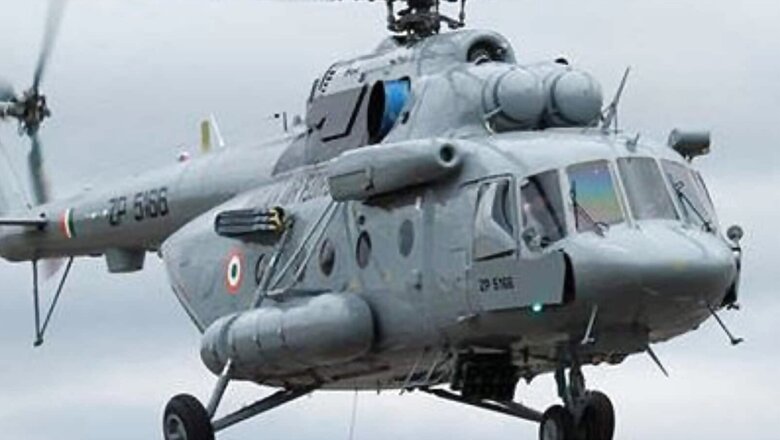
views
On December 8, 2021 Indian Air Force’s helicopter Mi-17V5 carrying 14 personnel, including Chief of the Defence Staff General Bipin Laxman Singh Rawat and his spouse Madhulika Rawat, crashed in Coonoor, Tamil Nadu, minutes before landing at my alma mater Defence Services Staff College, Wellington.
A lot of questions have been raised about the helicopter in which CDS Bipin Rawat was travelling. It is important for people to understand a few aspects of helicopters.
Nuances of Helicopter Flight
Helicopter, unlike a fixed-wing airplane, flies purely because of the thrust generated by the engine(s) which is transferred to the main rotor through MGB (Main Gear Box). The main rotor needs to produce thrust which is equivalent to the weight of the helicopter when in hovering condition. During the forward flight, helicopter tilts forward and due to this tilted vector, it stays airborne and moves forward. Readers must appreciate that helicopter stays airborne as long as there is power in the engine. When engine quits, the helicopter needs to trade height to maintain the main rotor rotation and the pilot has find a place to sit her down. This fall, called the autorotation, is near-vertical and survival from such an eventuality depends on the terrain below, weather and crew training. IAF pilots are well trained for such an eventuality, but the other two aspects (namely terrain and weather) are not in the control of the pilot. There are helicopters which have a single engine, like the Cheetah and the Chetak. Bigger helicopters like the Mi-17V5 have two engines.
Helicopters also have another peculiar design aspect: to counter the torque generated by the rotation of the main rotor so that the body (fuselage) does not rotate in the opposite direction. This counterbalance for a single-rotor helicopter is provided by the tail rotor. As you can appreciate, failure of the tail rotor could also lead to catastrophic failure.
Mi-17V5 is a Latest Helicopter
Mi-17V5 helicopter started its journey from the original basic design of Mi-8 helicopter, which flew first in 1975. I had the opportunity of flying in all versions of this helicopter, namely Mi-8, Mi-171V and Mi-17V5. Mi-17V-5 is the last in the Mi-8/17 family of helicopters that the IAF inducted. It is produced by Kazan Helicopters, a subsidiary of Russian Helicopters. I was the CATSPAW (Command Air Tasking and Strike Planning for Aerial Warfare), in other words the in-charge for operations, when we inducted Mi-17V5 into IAF in 2013; the last of these helicopters were inducted in 2018. I flew in it extensively, including in bad weather conditions, for weapon delivery and in other operations.
Understanding Mi-17V5
Mi-17V5 is a 13 tonne-class helicopter, which is powered by VK-2500 engine that provides a power output of 2,700hp. With this whopping 2700hp engine, it can quickly climb to an altitude of 18,000 feet and perform its task. It can transport 36 armed soldiers or 4,500kg of load on a sling. This is probably the only helicopter in the IAF’s inventory with full-authority digital control system (FADEC). FADEC controls the fuel flow and the rate of fuel flow to the engine depending on a number of factors, like temperature, outside pressure, engine internal pressure, helicopter demand etc. FADEC basically makes the engine inherently safe, efficient and reliable.
The Mi-17V5 has a maximum speed of 250km/h. With two auxiliary fuel tanks, it has a range of 1000+ kms and without it nearly 600 kms.
Mi-17V5 also has something called a Sur system and a Bambi bucket. Sur system allows three personnel to come down via rope controlled by the operator as opposed to the older version where soldier comes down via rope (called rappelling) on their own. Bambi Bucket is a huge underslung container which is used to douse forest fire. Using Bambi bucket, IAF had recently stopped a potential forest fire in the Northeast.
Not to mention, the Mi-17V5 is equipped with four swappable multifunction displays (MFDs): weather radar, radio altimeter giving accurate height measurement, night-vision equipment to fly in pitch dark conditions, and an exceptional autopilot which has the capability to auto hover. It also has KNEI-8 avionics suite which is designed to cue weapons integrated with navigation system for accurate delivery of its weapons, like the 80 mm rocket, Shturm-V missiles, 23mm cannons. On its doors and on the pods, it can be fitted with 8 firing posts with PKT machine guns and door guns, making it a potent gunship.
Mi-17V5 is Built Like a Tank
Unlike the previous versions of the Mi series helicopter, Mi-17V5 is built like a tank. It has infrared suppressors to give protection against heat-seeking missiles, chaff and flare dispenser to provide passive electronic warfare capability and a noise and deception jammer to evade radar-guided missiles. It simply means, it is nearly impossible to shoot down this helicopter with heat-seeking/radar-guided missiles. It has wire cutter in the front to cut wires if it inadvertently encounters cables. It is heavily protected by armoured plates which could be removed if required, protecting crew and vital areas of the helicopter from small arms fire. It has self-sealing fuel tanks made of a material called Hycatrol and it is also covered in a polyurethane fire retardant foam, giving it protection against explosions.
Mi-17V5 is indeed built like a tank.
The author is Group Captain (retd), Fighter Pilot, MiG-21, Mirage-2000. He is DGCA-nominated Qualified Flying Instructor and Aircraft Accident Investigator. The views expressed in this article are those of the author and do not represent the stand of this publication.
Read all the Latest Opinions here

















Comments
0 comment